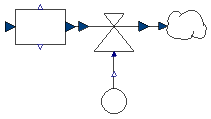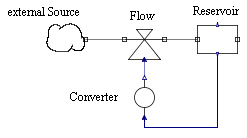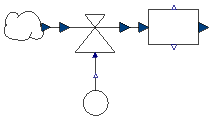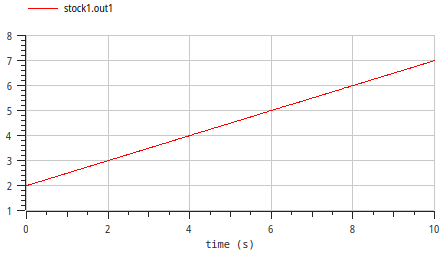Introduction to System Dynamics
- Simulations in biology, ecology or economy:
- highly complex systems
- causal relationships often unclear
- simulation as testbed to check new ideas
- mathematical formulation
- usually as differential equation
- often too abstract for users
- functional relationships often based on empiric
data (tables, plots)
- graphical modeling with system dynamics diagramms
- emphasis on causal relationships
- only very few general blocks
- mathematical relations are hidden, equations are
defined as parameters
- several commercial modeling and simulation
environments, e. g.
Stella, Vensim, Simile
- invented by Jay Forrester around 1955
- Basic building blocks of system dynamics diagrams:
- Reservoir (or stock)
- corresponds to a state variable
- needs initial value
- Flow
- defines rate of change (positive/negative) of a
reservoir
- connects reservoir with another reservoir or
external sources/sinks (cloud)
- is symbolized as a valve
- Converter
- external parameter or auxiliary variable
- computed using other values
- concrete computation is hidden as parameter
- Connector
- specifies, which variables affect others
- graphical representation
- Physical modeling:
- models built from "physical" components (masses,
resistors, valves) instead of integrators or function blocks
- connecting lines represent "physical" connections
(flanges, wires, pipes) instead of signals
- internal representation uses Modelica language
- object-oriented, equation-based modeling language
- provides means for graphical representation of
components and models
- huge free library of components (MSL = Modelica
standard library)
- simulation
- equations come from components and connections
- automatically combined, simplified (highly
non-trivial!) and numerically solved
- modeling and simulation environment
- Modelica library SystemDynamics.mo:
- based on SystemDynamics
2.0 by Cellier
- design changed to cope with blocks like Oven
- using library in OpenModelica
- start OMEdit
- load base library SystemDynamics.mo
und examples library SystemDynamicsExamples.mo
- both are displayed in Libraries
pane
- design of base library
- packages Reservoirs, Flows and Converters
- predefined components for common equations
- user-defined components necessary for special
mathematical relations
- definition of such components easy
- packages Interfaces
contains supporting auxiliary components
- design of example library
- Examples contains
executable models
- packages Examples for
executable models, AuxComponents
for auxiliary components
- required data sets in package Resources
- Simple growth model Inflow:
- only one state variable
- growth (inflow)
- defined by flow (valve symbol)
- rate variable (i. e. amount/time)
- defined by ConstantConverter
- diagram
- Building the model:
- pick up components from library pane and drag them
into model pane
- form Reservoirs: Stock, CloudSource
- from Flows: Flow
- from Converters: ConstantConverter
- connect components
- set parameter values (after double click on a
component)
- initial value of reservoir (Stock):
m0 = 2
- inflow rate (ConstantConverter):
constValue = 0.5
- Running simulation:
- check model
- setup and run simulation
- Stop Time = 10
- automatically runs simulation
- → one output window is shown
- change window size (plot window icons "hidden"
top-right)
- choose variable: Inflow.stock1.out1
- use switch at bottom-right to retrun to model pane
- Model Outflow:
- mirror image of Inflow

- initial value m0 = 4
- simulation
- stock value becomes negative
- is a negative level meaningful?
- alternative: use SaturatedStock
with minLevel = 0
- result





